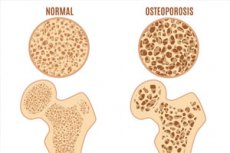New research examines whether adequate sleep may help prevent osteoporosis
Sist anmeldt: 14.06.2024

Alt iLive-innhold blir gjennomgått med medisin eller faktisk kontrollert for å sikre så mye faktuell nøyaktighet som mulig.
Vi har strenge retningslinjer for innkjøp og kun kobling til anerkjente medieområder, akademiske forskningsinstitusjoner og, når det er mulig, medisinsk peer-evaluerte studier. Merk at tallene i parenteser ([1], [2], etc.) er klikkbare koblinger til disse studiene.
Hvis du føler at noe av innholdet vårt er unøyaktig, utdatert eller ellers tvilsomt, velg det og trykk Ctrl + Enter.

As part of the University of Colorado Department of Medicine's annual Research Day on April 23, faculty member Kristin Swanson, MD, MS, described her National Institutes of Health-funded clinical research on whether adequate sleep can help prevent osteoporosis..
"Osteoporosis can occur for many reasons, such as hormonal changes, aging and lifestyle," said Swanson, assistant professor of endocrinology, metabolism and diabetes. “But some patients I see have no explanation for their osteoporosis.
It is therefore important to look for new risk factors and consider what changes over the course of life, just like bones -; sleep is one of those," she added.
How bone density and sleep change over time
In people's early and mid-20s, people reach what's called peak bone mineral density, which is higher in men than women, Swanson said. This peak is one of the main determinants of the risk of fractures later in life.
After reaching this peak, human bone density remains approximately stable for several decades. Then, when women enter menopause, they experience accelerated bone loss. Men also experience decreased bone density as they age.
Sleep patterns also change over time. As people age, total sleep time decreases and sleep composition changes. For example, sleep latency, which is the time it takes to fall asleep, increases with age. On the other hand, slow wave sleep, which is deep restorative sleep, decreases as we age.
"And it's not just sleep duration and composition that change. Circadian phase preferences also change across the lifespan in men and women," Swanson said, referring to people's preferences for when they go to bed and when they wake up.
How does sleep relate to our bone health?
The genes that control our internal clock are present in all our bone cells, Swanson said.
When these cells reabsorb and form bone, they release certain substances into the blood, which allows us to estimate how much bone turnover is occurring at a given moment.
Kristin Swanson, MD, MS, Instructor, University of Colorado Department of Medicine
These markers of bone resorption and formation follow a circadian rhythm. The amplitude of this rhythm is greater for markers of bone resorption—the process of bone breakdown—than for markers of bone formation, she said.
"This rhythmicity is likely important for normal bone metabolism and suggests that disturbances in sleep and circadian rhythms may directly influence bone health," she said.
Research on the link between sleep and bone health
To further explore this connection, Swanson and colleagues examined how markers of bone turnover respond to cumulative sleep restriction and circadian rhythm disruption.
In this study, participants were placed in a fully controlled, inpatient environment. The participants did not know what time it was and were switched to a 28-hour schedule instead of a 24-hour day.
"This circadian disruption is designed to mimic the stresses of working night shifts and is roughly equivalent to flying across four time zones to the West every day for three weeks," she said. "The protocol also resulted in a reduction in sleep time among participants."
The research team measured markers of bone turnover at the beginning and end of this intervention and found significant adverse changes in bone turnover in men and women in response to sleep and circadian rhythm disturbances. Adverse changes included decreases in markers of bone formation, which were significantly higher in young people of both sexes compared to older people.
In addition, a significant increase in a marker of bone resorption was found in young women.
If a person forms less bone while resorbing the same amount—or even more—over time, this can lead to bone loss, osteoporosis and an increased risk of fractures, Swanson said.
"Gender and age may play an important role, with younger women potentially most susceptible to the adverse effects of poor sleep on bone health," she said.
Research in this area continues, she added.
